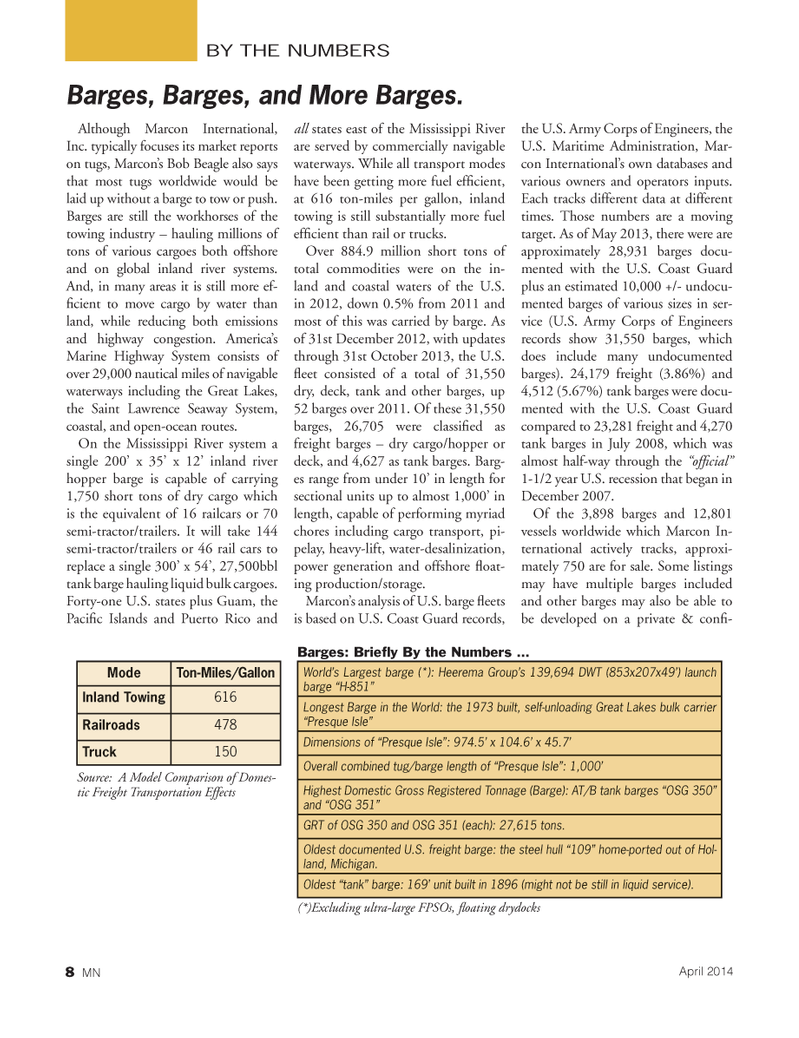
Page 8: of Marine News Magazine (April 2014)
Shipyard Report: Construction & Repair
Read this page in Pdf, Flash or Html5 edition of April 2014 Marine News Magazine
BY THE NUMBERSAlthough Marcon International, Inc. typically focuses its market reports on tugs, Marcon?s Bob Beagle also says that most tugs worldwide would be laid up without a barge to tow or push. Barges are still the workhorses of the towing industry ? hauling millions of tons of various cargoes both offshore and on global inland river systems. And, in many areas it is still more ef- cient to move cargo by water than land, while reducing both emissions and highway congestion. America?s Marine Highway System consists of over 29,000 nautical miles of navigable waterways including the Great Lakes, the Saint Lawrence Seaway System, coastal, and open-ocean routes. On the Mississippi River system a single 200? x 35? x 12? inland river hopper barge is capable of carrying 1,750 short tons of dry cargo which is the equivalent of 16 railcars or 70 semi-tractor/trailers. It will take 144 semi-tractor/trailers or 46 rail cars to replace a single 300? x 54?, 27,500bbl tank barge hauling liquid bulk cargoes. Forty-one U.S. states plus Guam, the Paci c Islands and Puerto Rico and all states east of the Mississippi River are served by commercially navigable waterways. While all transport modes have been getting more fuel ef cient, at 616 ton-miles per gallon, inland towing is still substantially more fuel ef cient than rail or trucks. Over 884.9 million short tons of total commodities were on the in- land and coastal waters of the U.S. in 2012, down 0.5% from 2011 and most of this was carried by barge. As of 31st December 2012, with updates through 31st October 2013, the U.S. eet consisted of a total of 31,550 dry, deck, tank and other barges, up 52 barges over 2011. Of these 31,550 barges, 26,705 were classi ed as freight barges ? dry cargo/hopper or deck, and 4,627 as tank barges. Barg- es range from under 10? in length for sectional units up to almost 1,000? in length, capable of performing myriad chores including cargo transport, pi- pelay, heavy-lift, water-desalinization, power generation and offshore oat-ing production/storage. Marcon?s analysis of U.S. barge eets is based on U.S. Coast Guard records, the U.S. Army Corps of Engineers, the U.S. Maritime Administration, Mar- con International?s own databases and various owners and operators inputs. Each tracks different data at different times. Those numbers are a moving target. As of May 2013, there were are approximately 28,931 barges docu- mented with the U.S. Coast Guard plus an estimated 10,000 +/- undocu-mented barges of various sizes in ser- vice (U.S. Army Corps of Engineers records show 31,550 barges, which does include many undocumented barges). 24,179 freight (3.86%) and 4,512 (5.67%) tank barges were docu- mented with the U.S. Coast Guard compared to 23,281 freight and 4,270 tank barges in July 2008, which was almost half-way through the ?of cial? 1-1/2 year U.S. recession that began in December 2007. Of the 3,898 barges and 12,801 vessels worldwide which Marcon In- ternational actively tracks, approxi- mately 750 are for sale. Some listings may have multiple barges included and other barges may also be able to be developed on a private & con -Barges, Barges, and More Barges. World?s Largest barge (*): Heerema Group?s 139,694 DWT (853x207x49?) launch barge ?H-851? Longest Barge in the World: the 1973 built, self-unloading Great Lakes bulk carrier ?Presque Isle? Dimensions of ?Presque Isle?: 974.5? x 104.6? x 45.7? Overall combined tug/barge length of ?Presque Isle?: 1,000? Highest Domestic Gross Registered Tonnage (Barge): AT/B tank barges ?OSG 350? and ?OSG 351?GRT of OSG 350 and OSG 351 (each): 27,615 tons.Oldest documented U.S. freight barge: the steel hull ?109? home-ported out of Hol- land, Michigan.Oldest ?tank? barge: 169? unit built in 1896 (might not be still in liquid service). ModeT on-Miles/GallonInland Towing 616Railroads 478Truck 150Barges: Brieß y By the Numbers É Source: A Model Comparison of Domes- tic Freight Transportation Effects (*)Excluding ultra-large FPSOs, oating drydocks 8 MNApril 2014MN April14 Layout 1-17.indd 8MN April14 Layout 1-17.indd 83/21/2014 11:14:47 AM3/21/2014 11:14:47 AM

 7
7

 9
9
